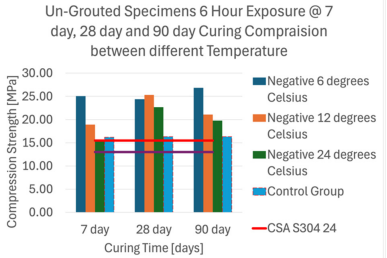Rui Zhong and Graziano Fiorillo
i M.Sc. Student, Civil Engineering, University of Manitoba, Winnipeg, MB, Canada, zhongr@myumanitoba.ca
ii Assistant Professor, Civil Engineering, University of Manitoba, Winnipeg, MB, Canada, graziano.fiorillo@umanitoba.ca
ABSTRACT
Cold temperatures challenge masonry structures in terms of long-term durability problems and short-term construction difficulties. Low temperatures reduce the heat of hydration required for both mortar and grout, slowing or even entirely pausing the hydration reaction until temperatures return to suitable levels; then, the structure can fully withstand the expected strength and serve as designed. The water content in the mortar and grout starts freezing below -2.8 ℃ (26.96 ℉). Frozen water increases porosity, prolongs curing, reduces strength, and may shorten the masonry’s lifespan. Research has emerged on the effects of the freeze-thaw cycles on masonry structures, the inner microstructure damage caused by the frost influence, the insulation applied on structures to reduce freezing temperatures effects, the long-term freeze-thaw damage observation, and the frost effect on structure seismic strength effects. While many studies have investigated the long-term durability of mature masonry under freeze-thaw cycles, there is limited research on how low temperatures and for how long the strength of newly constructed masonry exposed to cold temperatures could be affected. This work aims to study the effects of freezing temperatures on the strength development of masonry structures during the first 0 to 48 hours after construction. Thus, to further understand the phenomenon and the actual behaviour of masonry components curing under cold weather conditions, multiple groups of concrete masonry specimens were assembled and moved into an environmental chamber with temperatures equal to -6 ℃ (21.2 ℉), -12 ℃ (10.4 ℉), and -24 ℃ (-11.2 ℉), and the exposure time of 6, 24, and 48 hours. The specimens were tested for compressive strength after 7, 28, and 90 days of maturity to elucidate the effects of cold weather on newly constructed masonry elements. As a result, even though some specimens showed a delay in strength growth, eventually, all specimens’ compressive strength reached a value higher than the compressive strength required by CSA S304 for ungrouted and grouted hollow concrete masonry assemblages.
KEYWORDS: Masonry Prism Compressive Strength, Concrete Blocks, Extreme Cold Temperature, Exposure Time, Curing Time, Strength Delay.
021-Zhong.pdf



